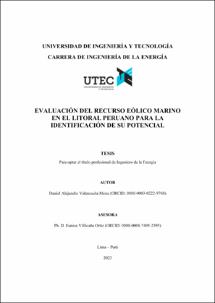| dc.contributor.advisor | Villicaña Ortiz, Eunice | |
| dc.contributor.author | Valenzuela Mena, Daniel Alejandro | |
| dc.date.accessioned | 2024-07-16T22:12:26Z | |
| dc.date.available | 2024-07-16T22:12:26Z | |
| dc.date.issued | 2023 | |
| dc.identifier.citation | Valenzuela Mena, D. A. (2023). Evaluación del recurso eólico marino en el litoral peruano para la identificación de su potencial [Tesis de Título Profesional, Universidad de Ingeniería y Tecnología]. Repositorio Institucional UTEC. https://hdl.handle.net/20.500.12815/388 | es_PE |
| dc.identifier.uri | https://hdl.handle.net/20.500.12815/388 | |
| dc.description.abstract | En Perú, el análisis de factibilidad para la energía eólica marina ha sido desarrollado únicamente por dos estudios, que comparten el factor de haberse enfocado principalmente en las velocidades de viento. Mediante la presente investigación, se exploró mayor cantidad de información relevante para el desarrollo de la eólica offshore en el país. Específicamente, se efectuó un análisis que incluyó la batimetría, caracterización del viento, dos impactos ambientales (a áreas naturales protegidas y el visual) y el costo nivelado de energía asociado a implementar la tecnología eólica costa afuera en el mar de Grau. En esa línea, se llegó a los siguientes resultados relevantes: La fosa marina Perú-Chile limita el uso de fundaciones fijadas al fondo. Según las profundidades extraídas del litoral por GEBCO, hay zonas a menos de 2 km de la costa donde se debe utilizar cimentaciones flotantes. La base de datos ERA5 utilizada en el periodo 1979-2018 muestra que el mayor promedio de velocidad en el litoral peruano, 10.04 m/s a 100 m de altura de medición, se encuentra en un píxel de aproximadamente 27 km x 27 km frente a la Reserva Nacional de Paracas. Solo 40 km2 de superficie entre 10 km y 160 km afuera de la costa coinciden con ser a la vez mayores a los 7 m/s y requerir fundaciones del tipo fijadas al fondo. Zonas factibles para el desarrollo de energía eólica marina se localizan en los alrededores de tres reservas nacionales: Paracas, Islas Ballestas - Islas Chincha y San Fernando. La mejor zona factible, frente a los distritos de Magdalena y Santiago de Cao (La Libertad) no posee inconvenientes relacionados al impacto visual. El LCOE en dicha zona factible es de 112.66 $/MWh, lo que se calculó con base en una turbina Aerodyn 8.0 MW / 168 m. | es_PE |
| dc.description.abstract | Available information about offshore wind energy in Peru is currently limited. Only two studies have been developed and they share the fact of being mainly focused in wind velocities. As a response, this thesis tries to reduce the lack of information and integrate values of bathymetry, wind characterization, conservation areas, visual impacts and levelized cost of energy about implementing offshore wind energy in the front of the Peruvian coast. This way, the following remarkable results were obtained: The Peru-Chile marine trench limits the use of fixed-bottom foundations. According to the depths extracted from the offshore coast by GEBCO, there are areas less than 2 km away from the coast where floating foundations are needed. The ERA5 database used in the 1979-2018 period shows that the highest average speed in the Peruvian coast, 10.04 m/s at 100 m measurement height, is found in 27 km x 27 km pixel in front of the Paracas National Reserve. Only 40 km2 of surface between 10 km and 160 km off the coast coincide with being at the same time greater than average 7 m/s speed and require foundations bottom-fixed. Feasible areas for offshore wind energy development are located around three national reserves: Paracas, Islas Ballestas - Islas Chincha and San Fernando. The best feasible area, in front of Magdalena and Santiago de Cao districts, has no drawbacks related to visual impacts. The LCOE in above mentioned feasible zone is 112.66 $/MWh. This was calculated based on a Aerodyn 8.0 MW / 168 m turbine. | es_PE |
| dc.description.uri | Tesis | es_PE |
| dc.format | application/pdf | es_PE |
| dc.language.iso | spa | es_PE |
| dc.publisher | Universidad de Ingeniería y Tecnología | es_PE |
| dc.rights | info:eu-repo/semantics/openAccess | es_PE |
| dc.rights.uri | http://creativecommons.org/licenses/by-nc-nd/4.0/ | |
| dc.source | Repositorio Institucional UTEC | es_PE |
| dc.source | Universidad de Ingeniería y Tecnología - UTEC | es_PE |
| dc.subject | Energía eólica | es_PE |
| dc.subject | Industria offshore | es_PE |
| dc.subject | Parques eólicos | es_PE |
| dc.subject | Wind energy | es_PE |
| dc.subject | Offshore industry | es_PE |
| dc.subject | Wind farms | es_PE |
| dc.title | Evaluación del recurso eólico marino en el litoral peruano para la identificación de su potencial | es_PE |
| dc.title.alternative | Offshore wind energy resource assessment to identify its potential for Peru | es_PE |
| dc.type | info:eu-repo/semantics/bachelorThesis | es_PE |
| dc.subject.ocde | https://purl.org/pe-repo/ocde/ford#2.07.03 | es_PE |
| dc.publisher.country | PE | es_PE |
| thesis.degree.discipline | Ingeniería de la Energía | es_PE |
| thesis.degree.grantor | Universidad de Ingeniería y Tecnología. Ingeniería de la Energía | es_PE |
| thesis.degree.level | Título Profesional | es_PE |
| thesis.degree.name | Ingeniero de la Energía | es_PE |
| renati.advisor.cext | 001377476 | |
| renati.advisor.orcid | https://orcid.org/0000-0001-7495-2395 | es_PE |
| renati.author.dni | 73149334 | |
| renati.author.orcid | https://orcid.org/0000-0003-0222-9768 | es_PE |
| renati.discipline | 711026 | es_PE |
| renati.juror | Ramirez Quiroz, Elmer Hernan | |
| renati.juror | Vera Pomalaza, Rafael | |
| renati.juror | Garcia Zanabria, Germain | |
| renati.level | https://purl.org/pe-repo/renati/level#tituloProfesional | es_PE |
| renati.type | https://purl.org/pe-repo/renati/type#tesis | es_PE |





